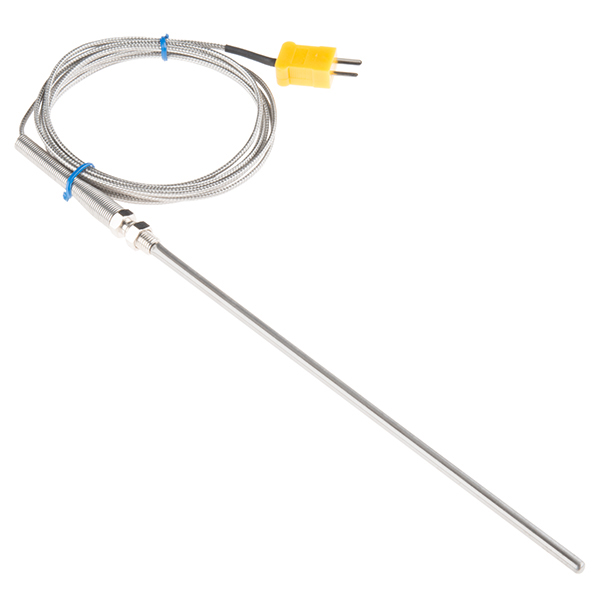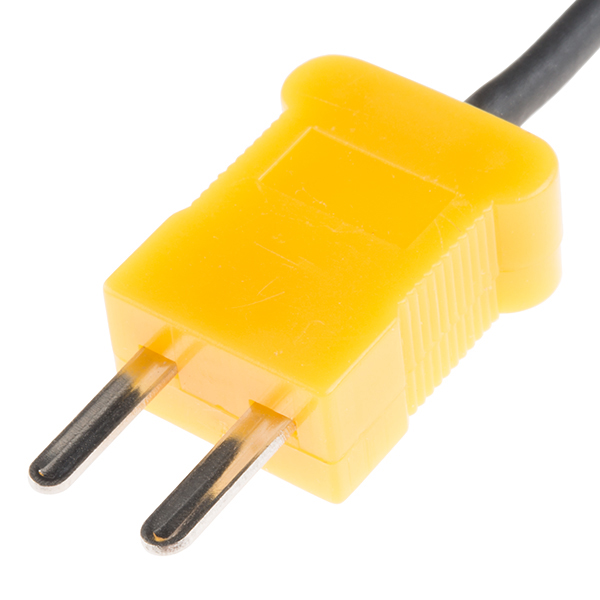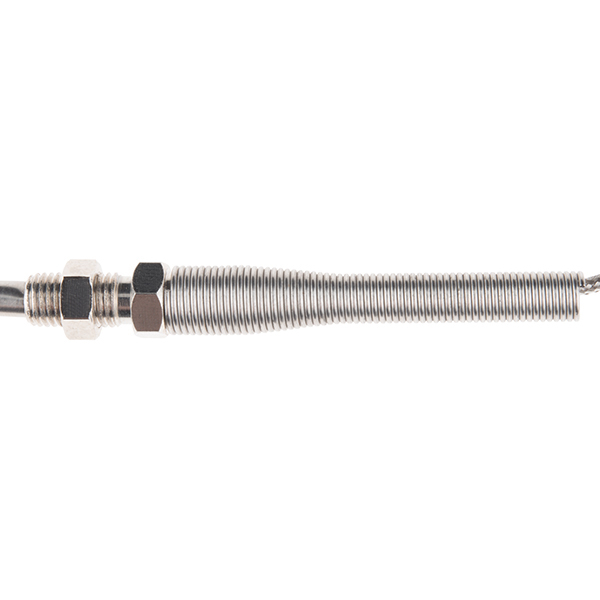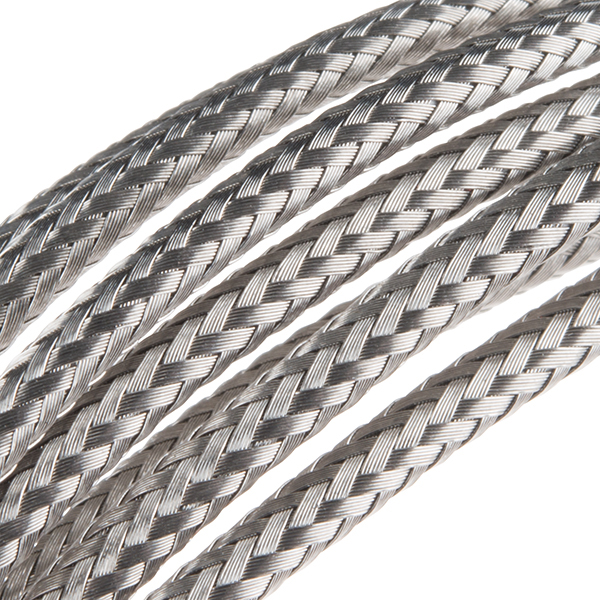Thermocouple Type-K - Stainless Steel
This is a stainless steel, Type-K Thermocouple probe. A thermocouple works by taking two wires made of dissimilar metals, connecting them at the two ends, and making a temperature gradient between one end and the other (a 'hot' end and a 'cold' one). Once this is achieved, a voltage potential is formed and current flows. One junction is held in the environment where the temperature of interest exists, this is known as the hot junction. The other junction, referred to as the cold junction, can typically be found in ICs that specialize in reading the temperatures detected by the thermocouple probe.
This common Type-K Thermocouple is made out of chromel and alumel, while offering a temperature high of 400°C and a low of 0°C. The probe itself is only 200mm (7.8in) long with a diameter of 5mm (~0.2in) and is terminated with a standard thermocouple connector.
Note: This Type-K Thermocouple probe is not intended to be used for food.
- Type-K
- Standard Thermocouple Connector
- Temperature Range: 0-400°C
- Probe Dia: 5mm
- Probe Material & Length: stainless steel, 200mm
Thermocouple Type-K - Stainless Steel Product Help and Resources
MAX31855K Thermocouple Breakout Hookup Guide
November 5, 2015
Learn how to take readings with a k-type thermocouple using the MAX31855K cold-junction-compensated k-type thermocouple-to-digital converter.
Core Skill: Electrical Prototyping
If it requires power, you need to know how much, what all the pins do, and how to hook it up. You may need to reference datasheets, schematics, and know the ins and outs of electronics.
Skill Level: Rookie - You may be required to know a bit more about the component, such as orientation, or how to hook it up, in addition to power requirements. You will need to understand polarized components.
See all skill levels
Comments
Looking for answers to technical questions?
We welcome your comments and suggestions below. However, if you are looking for solutions to technical questions please see our Technical Assistance page.
Customer Reviews
3.5 out of 5
Based on 4 ratings:
Well made
Nice probe. The connector is easy to remove as I didn't need it for my application. All metal construction makes it easy to clean.
Beware! Thermocouple electrically connected to housing
If you ground the housing and try to read this probe out with the MAX31855K breakout board, you must float your Arduino and everything else otherwise it doesn't work. I have a more expensive probe from another source which is electrically isolated.
Still, the price is so low it is good for some applications.
not for a reflow oven
I tried to use this probe inside my reflow oven project, the temperature measured is not correct, >10°C less than the one measured with my multi-meter.
Seems fine
Combined it with the SparkFun Qwiic Thermocouple Amplifier - MCP9600
It read 2.3 C in an ice bath (my kitchen thermometer read 0.6 C for reference) It read 99.5 C in boiling water pretty close to sea level.
MCP9600 specifies a worst case accuracy of ±1.5°C, so my tests showed something was out of spec. No idea if the thermocouple or MCP9600 is at fault though.
Also, the thermocouple is no longer electrically connected to the housing. Maybe Sparkfun got a new supplier since Member #32186 left their review?
no complaints about the physical construction.






Does anyone know of a Thermocouple or probe with a datasheet which is food grade? What makes this one not food grade? Can it leach chemicals into the food from its materials?
I think K type thermocouples are good to -200C
What is the accuracy of this thermocouple? Is it tolerance class 1 (+-1.5 degrees C) or 2 (+- 2.5 degrees C)?
As a complete newbie to thermocouples, I'm curious about their ability (inability?) to provide absolute temperature readings.. I did some reading on the wiki pages, and although I admit that my eyes glazed over at some of the advanced math, it seems to indicate that the reading you get is a RELATIVE reading between the tip and the rest of the probe. If this is the case, do people typically have a separate thermometer external to their tested object to collect ambient temperature, or do people just assume "room temperature" and just figure it's close enough?
The two projects I'm interested in right now are building a pool water temperature probe, and a probe to monitor the temperature inside of a smoker grill (not in the meat, just the air in the smoker) Anyone have any hints or best practices on this?
Just some clarity, the thermocouple will produce a voltage difference at each conductor transition in the circuit. It will work correctly if the tip is at the region you want to measure, and the wire type for K is all chromel/alumel up to the circuit board (in the case of this product). The chip reads the chip of the board and gives the temp of the thermocouple tip. They can give off readings when the sheath is bent and the internal wires contact somewhere other than the tip.
1) Are these isolated from - or - grounded to the sheath? 2) "Temperature Range: 0-400°C" - what limits the high temp spec to 400°C? 3) "The probe itself is only 200mm (7.8in) long" - so, how long are the lead wires?
Excellent price for a sheathed thermocouple!
I was wondering about some of the same things, and now that I have one here, I did some measurements. (1) The multimeter showed there is an open circuit (>2 Megaohms anyway) between either of the pins of the plugs and the tip of the sheath, so the sheath is isolated. Thus it may be connected to ground without further ado. The MAX31855 digitizer will be happy and won't flag the SCG (Thermocouple shorted to GND). (3) The cable from top of the probe to the fitted plug is about 1.75 meters (or 5 feet 8 inches) long, making the entire assembly almost 2 meters from the tip of the probe to the tips of the pins on the plug. (2) This is just my speculation, but maybe the max temperature limit has to do with some kind of plastic parts located in the tip of the sheath where the hot thermocouple junction is isolated -- maybe this will melt at higher temperatures?
Will this thermocouple tolerate the direct flame heat of a natural gas pilot light? If not, what about the other one carried on Sparkfun?
I am making a pilot light loss sensor / warning alarm for my furnace and water heater as it is very rude to wake up and discover one or the other appliance is not operating. (Generally due to very windy conditions.)
Are these isolated or grounded to the sheath? In other words if you measure from either of the connections to the sheath will it be a high or low impedance? It seems fairly obvious it must be usable to far below zero C. Also if it is washed it is quite likely the sheathed portion could be used on food since it is stainless steel.
This is a vey good price for a sheathed thermocouple!
How about a high temp version? Need to measure up to 2600°F
0 Celsius seems high for the low temperature limit. Could this be double-checked? It's not obvious to me why a stainless steel probe could not be taken to -50C or lower.
Is it waterproof, can I keep it as submerged all the time?
if you only submerge the sheath, you are fine. You may want to get creative if you want to mount it in a deeper than that.
Is it "food grade"? Can I stick it in a turkey?